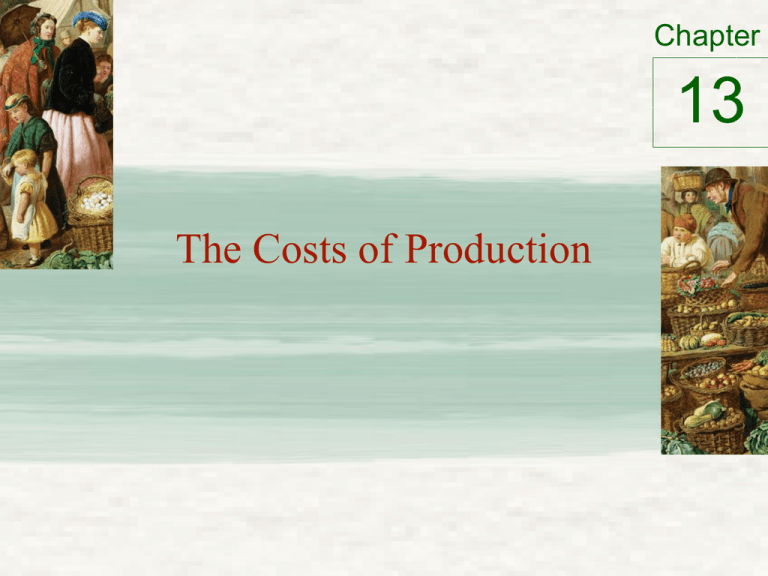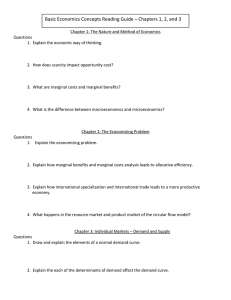The Costs of Production
advertisement

Chapter
13
The Costs of Production
What Does a Firm Do?
• Firm’s Objective
– Firms seek to maximize profits
• Profits = Total Revenues minus Total Costs
• Choose Q such that Max {TR(Q*) –TC{Q*}
• Total revenue
– Revenue received fromsale of its output
• Total cost
– Market value of the inputs a firm uses in
production
2
Why Are Costs Important to a Firm?
• Primary economic objective of a firm
– Maximize profits
• Total revenues depend on customer demand
• Tot Rev(Q) = Price(Qd) x Qd
– Price-taker (competitive world)
»
»
»
»
Initially assume: firm is a Price-taker (competitive world)
Competitors numerous and perfect substitutes
Demand is perfectly elastic
Tot Rev is not controllable by firm
• Costs {can controlled by p-taking firm}
– Depend on amount supplied (Q*) by the firm
– prices of and amounts used of inputs
3
What are Costs?
• Costs as opportunity costs
– Explicit costs
• Input costs that require an outlay of money by
the firm
• Reflect value of input used by other
producers/markets – price willing to pay
– Implicit costs
• Input costs that do not require an outlay of
money by the firm
• Opportunity costs of time; alternative investment
4
Table
1
A production function and total cost: Caroline’s cookie
factory
Number
of workers
Output
(quantity of cookies
produced per hour)
Marginal
product
of labor
0
1
2
3
4
5
6
0
50
90
120
140
150
155
50
40
30
20
10
5
Cost of
factory
Cost of
workers
Total cost of inputs
(cost of factory +
cost of workers)
$30
30
30
30
30
30
30
$0
10
20
30
40
50
60
$30
40
50
60
70
80
90
5
Figure 2
Caroline’s production function and total-cost curve
Quantity
of Output
(cookies
per hour)
(a) Production function
Production
function
$90
160
80
140
70
120
60
100
50
80
40
60
30
40
20
20
10
0
1
2
3
4
5
(b) Total-cost curve
Total
Cost
6 Number of
Workers Hired
0
Total-cost curve
20
40
60
80 100 120 140 160 Quantity
of Output
(cookies per hour)
The production function in panel (a) shows the relationship between the number of workers hired and the quantity of
output produced. Here the number of workers hired (on the horizontal axis) is from the first column in Table 1, and the
quantity of output produced (on the vertical axis) is from the second column. The production function gets flatter as the
number of workers increases, which reflects diminishing marginal product. The total-cost curve in panel (b) shows the
relationship between the quantity of output produced and total cost of production. Here the quantity of output produced
(on the horizontal axis) is from the second column in Table 1, and the total cost (on the vertical axis) is from the sixth
column. The total-cost curve gets steeper as the quantity of output increases because of diminishing marginal product. 6






